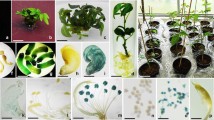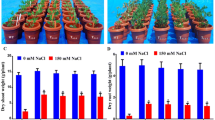Abstract
Salinity and drought are main threat to agriculture productivity, to avoid further losses it is necessary to improve the genetic material of crops against these stresses In this present study, AtNHX1, a vacuolar type Na+/H+ antiporter gene driven by 35S promoter was introduced into groundnut using Agrobacterium tumefaciens transformation system. The stable integration of the AtNHX1 gene was confirmed by polymerase chain reaction (PCR) and southern blot analysis. It was found that transgenic plants having AtNHX1 gene are more resistant to high concentration of salt and water deprivation than the wild type plants. Salt and proline level in the leaves of the transgenic plants were also much higher than that of wild type plants. The results showed that overexpression of AtNHX1 gene not only improved salt tolerance but also drought tolerance in transgenic groundnut. Our results suggest that these plants could be cultivated in salt and drought-affected soils.






Similar content being viewed by others

References
Agrwal, P. K., Agarwal, P., Reddy, M. K., & Sopory, S. K. (2006). Role of DREB transcription factors in abiotic and biotic stress tolerance in plants. Plant Cell Reports, 25, 1263–1274.
FAO (Food, Agriculture Organization of the United Nations). (2004). FAO production yearbook. Rome: FAO.
Burke, E. J., Brown, S. J., & Christidis, N. (2006). Modeling the recent evolution of global drought and projections for the twenty-first century with the Hadley centre climate model. Journal of Hydrometeorology, 7, 1113–1125.
ICBA Annual Report 2006 (1426–27H). (2007). International Center for Biosaline Agriculture. Dubai: UAE.
Tal, M., & Shannon, M. C. (1983). Salt tolerance in the wild relatives of the cultivated tomato: responses of Lycopersicon esculentum, Lycopersicon cheesmani, Lycopersicon peruvianum, Solanum pennelli, and F1 hybrids to high salinity. Australian Journal of Plant Physiology, 10, 109–111.
Glenn, E. P., Brown, J. J., & Blumwald, E. (1999). Salt tolerance and crop potential of halophytes. Critical Reviews in Plant Sciences, 18, 227–255.
Yamaguchi, T., & Blumwald, E. (2005). Developing salt-tolerant crop plants: Challenges and opportunities. Trends in Plant Science, 10, 615–620.
Sottosanto, J. B., Saranga, Y., & Blumwald, E. (2007). Impact of AtNHX1, a vacuolar Na+/H+ antiporter, upon gene expression during short and long-term salt stress in Arabidopsis thaliana. BMC Plant Biology, 7, 18.
Zhang, H. X., & Blumwald, E. (2001). Transgenic salt-tolerant tomato plants accumulate salt in foliage but not in fruit. Nature Biotechnology, 19, 765–768.
Zhang, H. X., Hodson, J. N., Williams, J. P., & Blumwald, E. (2001). Engineering salt-tolerant Brassica plants: Characterization of yield and seed oil quality in transgenic plants with increased vacuolar sodium accumulation. Proceedings of the National Academy of Sciences of the United States of America, 98, 12832–12836.
Ohta, M., Hayashi, Y., Nakashima, A., Hamada, A., Tanaka, A., Nakamura, T., et al. (2002). Introduction of a Na+/H+ antiporter gene from Atriplex gmelini confers salt tolerance to rice. FEBS Letters, 532, 279–282.
Chen, H., An, R., Tang, J. H., Cui, X. H., Hao, F. S., Chen, J., et al. (2007). Over-expression of a vacuolar Na+/H+ antiporter gene improves salt tolerance in an upland rice. Molecular Breeding, 19, 215–225.
Yin, X. Y., Yang, A. F., Zhang, K. W., & Zhang, J. R. (2004). Production and analysis of transgenic maize with improved salt tolerance by the introduction of AtNHX1 gene. Acta Botanica Sinca, 46, 854–861.
Xue, Z. Y., Zhi, D. Y., Xue, G. P., Zhang, H., Zhao, Y. X., & Xia, G. M. (2004). Enhanced salt tolerance of transgenic wheat (Tritivum aestivum L.) expressing a vacuolar Na+/H+ antiporter gene with improved grain yields in saline soils in the field and a reduced level of leaf Na+. Plant Science, 167, 849–859.
Tian, L., Huang, C., Yu, R., Liang, R., Li, Z., Zhang, L., et al. (2006). Overexpression AtNHX1 confers salt-tolerance of transgenic tall fescue. African Journal of Biotechnology, 5, 1041–1044.
Chen, L. H., Zhang, B., & Xu, Z. Q. (2008). Salt tolerance conferred by overexpression of Arabidopsis vacuolar Na+/H+ antiporter gene AtNHX1 in common buckwheat (Fagopyrum esculentum). Transgenic Research, 17, 121–132.
Soliman, M. H., Omar, H. S., El-Awady, M. A., Al-Assal, S., & Gamal El-Din, A. Y. (2009). Transformation and expression of Na+/H+ antiporter vacuolar (AtNHX1) gene in tobacco plants under salt stress. Arab Journal of Biotechnology, 12, 99–108.
Xing, L. T., Yue, Z., Hua, L., Ting, W. U., Bin, L. W., & Xia, Z. H. (2010). Stable expression of Arabidopsis vacuolar Na+/H+ antiporter gene AtNHX1, and salt tolerance in transgenic soybean for over six generations. Chinese Science Bulletin, 55, 1127–1134.
Xu, K., Hong, P., Luo, L., & Xia, T. (2009). Overexpression of AtNHX1, a vacuolar Na+/H+ antiporter from Arabidopsis thalina, in Petunia hybrida enhances salt and drought tolerance. Journal of Plant Biology, 52, 453–461.
Knauft, D., & Akins, O. P. (1995). Recent methods for germplasm enhancement and breeding. In H. E. Pattee & I. I. T. Stalker (Eds.), Advances in peanut science (pp. 54–94). Stillwater: APRES.
http://faostat.fao.org/default.aspx. Accessed August 2010.
Gaoge, W., Yuhui, L., Peng, X., & Delin, D. (2005). A simple method for DNA extraction from sporophyte in the brown alga Laminaria ponica. Applied Phycology, 8, 1573–5176.
Epstein, E. (1972). Mineral nutrition of plants: Principles and perspectives (p. 398). New York, USA: Wiley.
Bates, L. S., Waldren, R. P., & Teare, I. D. (1973). Rapid determination of proline for water-stress studies. Plant and Soil, 39, 205–207.
Vinocur, B., & Altman, A. (2005). Recent advances in engineering plant tolerance to abiotic stress: Achievements and limitations. Current Opinion in Biotechnology, 16, 123–132.
Mathur, B. P., Vadez, V., & Sharma, K. K. (2008). Transgenic approaches for abiotic stress tolerance in plants: Retrospect and prospects. Plant Cell Reports, 27, 411–424.
Blumwald, E. (1987). Tonoplast vesicles for the study of ion transport in plant vacuoles. Physiologia Plantarum, 69, 731–734.
De Ronde, J. A., Laurie, R. N., Caetano, T., Greyling, M. M., & Kerepesi, I. (2004). Comparative study between transgenic and non-transgenic soybean lines proved transgenic lines to be more drought tolerant. Euphytica, 138, 123–132.
Yonamine, I., Yoshida, K., Kido, K., Nakagawa, A., Nakayama, H., & Shinmyo, A. (2004). Overexpression of NtHAL3 genes confers increased levels of proline biosynthesis and the enhancement of salt tolerance in cultured tobacco cells. Journal of Experimental Botany, 55, 387–395.
Acknowledgments
The authors are highly thankful to acknowledge the cooperation of Miss Anjuman Arif, of National Institute for Biotechnology and Genetic Engineering (NIBGE), Faisalabad, Pakistan and Director Barani Agricultural Research Institute (BARI) Chakwal, Pakistan for the providing the vector pGNFA-(pAHC17-AtNHX1) carrying AtNHX1 gene expression cassette and the seeds of groundnut varieties, respectively. The authors also acknowledge the support of Dr. Yusuf Zafar for his guidance and support during the studies conducted at National Institute for Genomics and Advanced Biotechnology, NARC, Islamabad, Pakistan.
Author information
Authors and Affiliations
Corresponding author
Rights and permissions
About this article
Cite this article
Asif, M.A., Zafar, Y., Iqbal, J. et al. Enhanced Expression of AtNHX1, in Transgenic Groundnut (Arachis hypogaea L.) Improves Salt and Drought Tolerence. Mol Biotechnol 49, 250–256 (2011). https://doi.org/10.1007/s12033-011-9399-1
Published:
Issue Date:
DOI: https://doi.org/10.1007/s12033-011-9399-1



